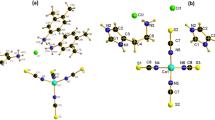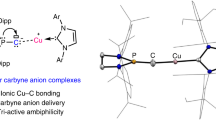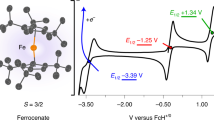Abstract
THE cobalt(III) complexes of pentacyano-type, [Co(CN)5 X], including several kinds of the new complex compounds, K3[Co(CN)5Cl], K3[Co(CN)5SCN], K3[Co(CN)5N3].2H2O, K3[Co(CN)5NO2] and K4[Co(CN)5SO3].2H2O, have been studied polarographically. The pentacyano complexes were found to be divisible into two groups from the point of view of their polarographic behaviour. The ions of one group, [Co(CN5Cl]3−, [Co(CN)5Br]3−, [Co(CN)5I]3− and [Co(CN)5SCN]3−, were reduced irreversibly in two steps to cobalt(I) complexes, through the cobalt(II) state at the dropping mercury electrode in potassium halide supporting electrolyte (Table 1). The ratio of the height of the first wave to that of the second is approximately 1 : 1.
This is a preview of subscription content, access via your institution
Access options
Subscribe to this journal
Receive 51 print issues and online access
$199.00 per year
only $3.90 per issue
Buy this article
- Purchase on Springer Link
- Instant access to full article PDF
Prices may be subject to local taxes which are calculated during checkout
Similar content being viewed by others
References
Pauling, L., “General Chemistry”, 277 (1948).
Maki, N., Shimura, Y., and Tsuchida, R., Bull. Chem. Soc. Japan, 30, 909 (1957).
Vlček, A. A., Nature, 180, 753 (1957).
Author information
Authors and Affiliations
Rights and permissions
About this article
Cite this article
MAKI, N., FUJITA, J. & TSUCHIDA, R. Polarography of Pentacyanocobaltate(III) Complexes. Nature 183, 458–459 (1959). https://doi.org/10.1038/183458a0
Issue Date:
DOI: https://doi.org/10.1038/183458a0
This article is cited by
-
Electronic absorption spectra of cobalt(III) pentacyanide complexes
Theoretical and Experimental Chemistry (1981)
-
New Univalent Cobalt Complexes of the [CoI(CN)5 X] Type
Nature (1960)
Comments
By submitting a comment you agree to abide by our Terms and Community Guidelines. If you find something abusive or that does not comply with our terms or guidelines please flag it as inappropriate.



